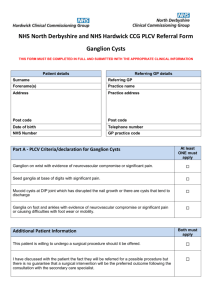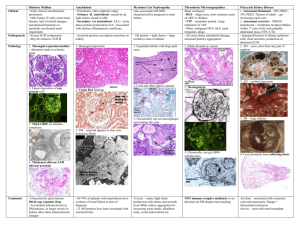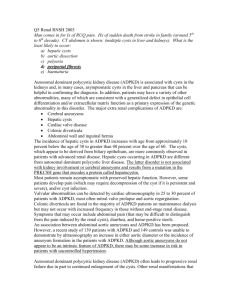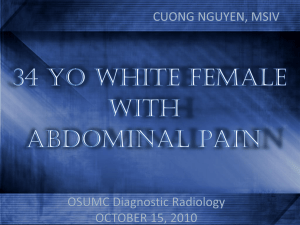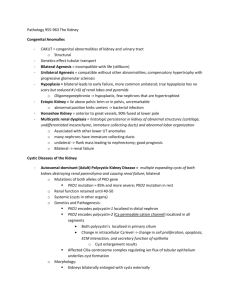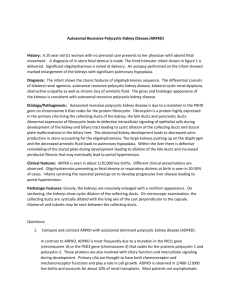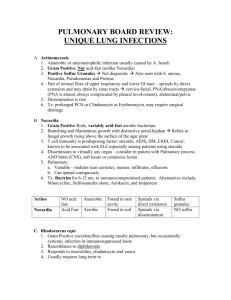Autosomal Dominant Polycystic Kidney Disease Carolynn DeBenedectis September 15, 2005
advertisement
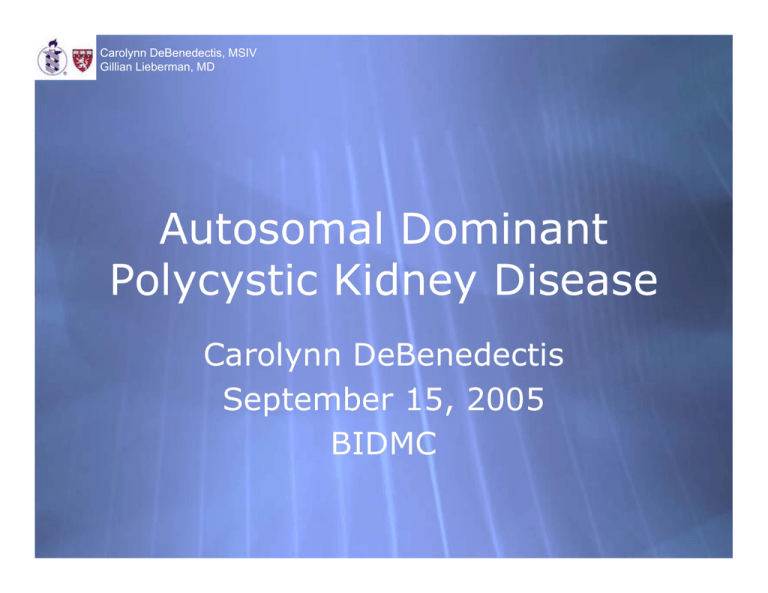
Carolynn DeBenedectis, MSIV Gillian Lieberman, MD Autosomal Dominant Polycystic Kidney Disease Carolynn DeBenedectis September 15, 2005 BIDMC Carolynn DeBenedectis, MSIV Gillian Lieberman, MD Case 47 year old female with a history of hypertension, hepatomegaly, early satiety, and some abdominal discomfort. Family history is significant for a father who died of renal failure. CT abdominal/pelvis was performed for a chief complaint of abdominal discomfort Carolynn DeBenedectis, MSIV Gillian Lieberman, MD CT Abdominal/Pelvis with IV contrast Cystic kidneys Cyst filled liver PACS, BIDMC PACS, BIDMC Carolynn DeBenedectis, MSIV Gillian Lieberman, MD Small sliding hiatal hernia Stomach protruding into the left hemithorax PACS, BIDMC Carolynn DeBenedectis, MSIV Gillian Lieberman, MD Hiatal Hernias Definition – proximal portion of the stomach slips thru the esophageal hiatus and into the thorax Sliding type – the gastroesophageal (GE) junction slides into the mediastinum above the diaphragm Most common type Paraesophageal type – the GE junction is in the normal location but the gastric fundus “rolls” into the mediastinum Can become infarcted, which is a surgical emergency Carolynn DeBenedectis, MSIV Gillian Lieberman, MD Specific CT findings in the liver Multiple fluid-filled cysts are seen throughout and largely replacing the right lobe of the liver There is diffuse hypertrophy of the liver parenchyma, with lateral displacement of the stomach wall Normal liver parenchyma cysts PACS, BIDMC Carolynn DeBenedectis, MSIV Gillian Lieberman, MD CT findings in the liver The largest liver cyst PACS, BIDMC Carolynn DeBenedectis, MSIV Gillian Lieberman, MD CT findings in the liver Liver extending into the pelvis PACS, BIDMC Iliac crests Carolynn DeBenedectis, MSIV Gillian Lieberman, MD CT findings in the liver Note the left lobe of the liver is partially clear of cysts ( note the amount of liver parenchyma) PACS, BIDMC Specific CT findings in the kidneys Carolynn DeBenedectis, MSIV Gillian Lieberman, MD Normal renal parenchyma cysts Multiple large cysts are seen replacing bilateral kidneys. Remaining renal parenchyma enhances normally There is symmetric excretion of contrast No enhancement of any of the visualized cysts Cyst enhancement would indicate cyst rupture, hemorrhage, or infection PACS, BIDMC kidneys Carolynn DeBenedectis, MSIV Gillian Lieberman, MD Asymmetric cystic involvement of the kidneys PACS, BIDMC Fewer cysts, more parenchyma More cysts, less parenchyma Wide variation in the size of the cysts PACS, BIDMC Large cyst Small cyst Carolynn DeBenedectis, MSIV Gillian Lieberman, MD Kidney Cysts Fluid-filled sacs arising from a dilatation in any part of the nephron or collecting duct. Renal cysts are quite common. The incidence of renal cysts increases with age, most people over the age of 60 have one or more simple renal cyst. Carolynn DeBenedectis, MSIV Gillian Lieberman, MD Differential Diagnosis Nongenetic Acquired disorders Simple renal cysts Cysts of the renal sinus Acquired cystic kidney disease (i.e. CRF) Multilocular cysts Hypokalemia-related cysts Developmental disorders Medullary sponge kidney Multicystic dysplastic kidney Pyelocalyoceal cysts Genetic Autosomal-dominant Autosomal-dominant polycystic kidney disease (ADPKD) Tuberous sclerosis complex von Hippel-Lindau disease Medullary cystic disease Glomerulocystic kidney disease Autosomal-recessive Autosomal-recessive polycystic kidney disease (ARPKD) Nephronophthisis X-linked Orofaciodigital syndrome, type I Carolynn DeBenedectis, MSIV Gillian Lieberman, MD Diseases that have renal cysts and liver cysts ADPKD Adult onset (4th or 5th decade) Large “bumpy” kidneys (due to renal cysts) Hepatic cysts Autosomal dominant inheritance ARPKD Childhood onset (at birth , and die young) Large, smooth kidneys (due to numerous small cysts) Hepatic cysts, congenital hepatic fibrosis, and biliary duct ectasia Autosomal recessive inheritance Tuberous sclerosis complex Renal cysts, liver cysts, and liver angiomylipomas Nephronophthisis Liver fibrosis, renal cysts, and hepatic cysts Carolynn DeBenedectis, MSIV Gillian Lieberman, MD Atlas of Disease of the Kidney, Schrier Carolynn DeBenedectis, MSIV Gillian Lieberman, MD Imaging of Renal Cysts Plain abdominal radiography IVP Radionucleotide imaging Ultrasound Computed tomography MRI Renal angiography Retrograde pyelography Carolynn DeBenedectis, MSIV Gillian Lieberman, MD Best Modalities for assessing Renal Cysts U/S is best for differentiating solid masses from cystic ones CT scan is best for finding small cysts and assessing for cystic rupture, infection, or hemorrhage (due to the use of contrast to get differential enhancement of cysts) MRI is useful for further characterizing renal cysts and detecting renal neoplasms Carolynn DeBenedectis, MSIV Gillian Lieberman, MD More Information About the Case Further research revealed that this patient’s father died of renal failure secondary to Autosomal Dominant Polycystic Kidney Disease This patient had been diagnosed with and worked up for ADPKD at an outside hospital previously Carolynn DeBenedectis, MSIV Gillian Lieberman, MD ADPKD Autosomal dominant hereditary condition characterized by multiple expanding cysts of both kidneys that ultimately destroy the renal parenchyma and cause renal failure 100% penetrance and affects 1 of every 400-1000 live births The majority of cases are caused by a mutation in the PKD1 gene on chromosome 16, which produces polycystin 1 (involved in cell-to cell interactions) The remainder of cases are caused by a mutation in PKD2 on chromosome 4, which produces polycystin 2 (less severe) Has variable expression and does not produce symptoms until adult life (4th or 5th decade of life) Carolynn DeBenedectis, MSIV Gillian Lieberman, MD PKD1 vs. PKD2 PKD1 Earlier presentation (average age 35) Earlier end-stage renal failure (average age 60) Earlier death (average age 70) PKD2 Later presentation (average age 61) Later end-stage renal failure (average age 74) Later death (average age 75) Carolynn DeBenedectis, MSIV Gillian Lieberman, MD ADPKD cont. Cysts may also occur within the liver, pancreas, and spleen Cysts are more common in the liver and tend to be less common in the pancreas and spleen Hepatic failure does not tend to occur despite extensive infiltration of the liver with cysts However, cysts in the liver and pancreas can lead to obstructive jaundice Circle of Willis aneurysms are present in up to 41% of patients that undergo cerebral angiography Carolynn DeBenedectis, MSIV Gillian Lieberman, MD ADPKD and imaging The imaging appearance varies with the severity of the disease Full-blown disease shows the presence of bilaterally enlarged kidneys with numerous cysts of varying sizes Ultrasound demonstrates cysts in the adolescent and young adult, who are usually asymptomatic Urography may be normal Ultrasound and CT are most sensitive MRI is useful for differentiating between simple cysts, hemorrhagic cysts, and neoplasms when CT and U/S are equivocal Carolynn DeBenedectis, MSIV Gillian Lieberman, MD Ultrasonographic Diagnostic Criteria for ADPKD The absence of cysts before age 30 does not rule out the diagnosis of ADPKD Age Cysts 15-29 2, uni/bilateral 30-59 2 in ea. kidney False negative rate is inversely proportional to age ≥60 4 in ea. kidney anechoic cyst If U/S diagnosis remains equivocal, CT should be used next (more sensitive for small cysts) Acoustic enhancement PACS, BIDMC Carolynn DeBenedectis, MSIV Gillian Lieberman, MD Example of the cystic involvement of the kidneys Classic Renal Imaging Findings in ADPKD Note the marked asymmetry in the number and size of cysts between the 2 kidneys CT is more sensitive at detecting small cysts than U/S Atlas of Disease of the Kidney, Schrier Small kidney with minimal cystic involvement Large kidney with multiple cysts of varying size Carolynn DeBenedectis, MSIV Gillian Lieberman, MD liver Classic Hepatic Imaging Findings in ADPKD Atlas of Disease of the Kidney, Schrier cysts Note the cystic involvement of the liver The presence of liver cysts helps to establish the diagnosis of ADPKD, especially if kidney involvement is mild Massive cystic disease of the liver can lead to early satiety, abdominal /diaphragmatic hernia, supine dyspnea, and rarely jaundice. Carolynn DeBenedectis, MSIV Gillian Lieberman, MD Prevalence of asymptomatic ICA in ADPKD is 8% (1.2% in the general population), increases to 16% with a family history of ICA Intracranial aneurysms (ICAs) and ADPKD ICA on the anterior communicating artery ICA rupture entail a mortality of 30-50% (results in SAH) First-line diagnostic procedure for ICA rupture is CT Atlas of Disease of the Kidney, Schrier Carolynn DeBenedectis, MSIV Gillian Lieberman, MD Indications for Screening for ICA in ADPKD Screening in ADPKD for ICA can be achieved with either MRA or spiral CT angiography Atlas of Disease of the Kidney, Schrier Carolynn DeBenedectis, MSIV Gillian Lieberman, MD Treatment Treatment is largely supportive The associated hypertension can be managed medically Renal failure can be managed with dialysis Kidney transplantation is the only way to “cure” the renal disease Carolynn DeBenedectis, MSIV Gillian Lieberman, MD Summary ADPKD is a disease with onset in adulthood ADKPD is associated with enlarged, cystic kidneys, hepatic cysts, pancreatic cysts, splenic cysts, and ICAs. U/S is the best imaging method for detecting renal cysts, however, CT may be more sensitive for small renal cysts It is important to screen ADPKD patients for ICA with spiral CT angiography or MRA in accordance with the appropriate indications. Carolynn DeBenedectis, MSIV Gillian Lieberman, MD References Grainger, R.G., Dixon, A.K., Allison, D.J., and Adamand, A. Grainger and Allison’s Diagnostic Radiology: A Textbook of Medical Imaging. 4th ed., Elsevier, 2001; pp.1557-1566. Daffner, Richard H. Clinical Radiology: The Essentials, 3rd ed. New York, Lippincott, Williams, and Wilkins, 1999; pp.341-386. Mettler, F.A. Mettler:Essentials of Radiology, 2nd ed., Elsevier, 2005; pp.192, and 218-19. Brenner, B.M. Brenner and Rector’s The Kidney, 7th ed., Elsevier, 2004; pp.1743-44. Kumer, V., Collins, T., and Robbins, S.L. Robbins:Pathologic Basis of Disease, 7th ed., 2005; pp.962-66. Schrier, Robert W. Atlas of Disease of the Kidney, Vol. II. Philadelphia, Current Medicine Inc., 1999; pp. 9.1-9.24. Fred, H.L. and Siddique, I.: Polycystic lver and Kidney Disease: Images in Clinical Medicine. NEJM, 333(1):31, 1995. Lang, E.K. and Davis, R.: Autosomal Dominant Polycystic Disease with Renal Cell Carcinoma. The Journal of Urology, 173(3):987, 2005. Little, D.M., et al.: Diaphragmatic Hernia Associated with Adult Polycystic Kidney Disease. The Journal of Urology, 162:2082-2083, 1999.

